Analysis Overview#
In this project, we aim to answer:
Which locations (and even streets, boroughs, and zip codes) in NY have a higher proportion of car accidents?
# !pip install geopandas
# !pip install geoplot
import numpy as np
import pandas as pd
import matplotlib.pyplot as plt
import plotly.express as px
from tool import utils
%matplotlib inline
from datetime import datetime
Importing Data#
The dataset we are working with is from the City of New York’s data catalog on motor vehicle crashes. The data contains information from all police reported motor vehicle collisions in NYC in 2012-2023. For the purposes of memory, we only use 2022 data. Click here to download the complete dataset. Be aware that this dataset is quite large and is of 403 Mb.
# read csv into dataframe, specifying the year
crashes = utils.read_csv_of_year(2022)
crashes.head(5)
| Unnamed: 0 | CRASH DATE | CRASH TIME | BOROUGH | ZIP CODE | LATITUDE | LONGITUDE | LOCATION | ON STREET NAME | CROSS STREET NAME | ... | CONTRIBUTING FACTOR VEHICLE 2 | CONTRIBUTING FACTOR VEHICLE 3 | CONTRIBUTING FACTOR VEHICLE 4 | CONTRIBUTING FACTOR VEHICLE 5 | COLLISION_ID | VEHICLE TYPE CODE 1 | VEHICLE TYPE CODE 2 | VEHICLE TYPE CODE 3 | VEHICLE TYPE CODE 4 | VEHICLE TYPE CODE 5 | |
|---|---|---|---|---|---|---|---|---|---|---|---|---|---|---|---|---|---|---|---|---|---|
| 0 | 1 | 2022-03-26 | 11:45 | NaN | NaN | NaN | NaN | NaN | QUEENSBORO BRIDGE UPPER | NaN | ... | NaN | NaN | NaN | NaN | 4513547 | Sedan | NaN | NaN | NaN | NaN |
| 1 | 2 | 2022-06-29 | 6:55 | NaN | NaN | NaN | NaN | NaN | THROGS NECK BRIDGE | NaN | ... | Unspecified | NaN | NaN | NaN | 4541903 | Sedan | Pick-up Truck | NaN | NaN | NaN |
| 2 | 34 | 2022-06-29 | 16:00 | NaN | NaN | NaN | NaN | NaN | WILLIAMSBURG BRIDGE OUTER ROADWA | NaN | ... | Unspecified | NaN | NaN | NaN | 4542336 | Motorscooter | Station Wagon/Sport Utility Vehicle | NaN | NaN | NaN |
| 3 | 37 | 2022-07-12 | 17:50 | BROOKLYN | 11225.0 | 40.663303 | -73.96049 | (40.663303, -73.96049) | NaN | NaN | ... | Unspecified | NaN | NaN | NaN | 4545699 | Sedan | NaN | NaN | NaN | NaN |
| 4 | 38 | 2022-03-23 | 10:00 | NaN | NaN | NaN | NaN | NaN | NaN | NaN | ... | NaN | NaN | NaN | NaN | 4512922 | Bike | NaN | NaN | NaN | NaN |
5 rows × 30 columns
Mapping#
Dropping NaNs in Locations column#
crashes["LOCATION"].isna().sum()
8938
crashes["LOCATION"].isna().sum()/crashes.shape[0]*100
8.611868538448938
crashes_locations_map = crashes.dropna(subset=["LOCATION"])
# crashes_locations_map.head()
Plotting total casualties#
crashes_locations_map["TOTAL CASUALTIES"] = crashes_locations_map["NUMBER OF PERSONS INJURED"] + crashes_locations_map["NUMBER OF PERSONS KILLED"]
/tmp/ipykernel_41499/4161608646.py:1: SettingWithCopyWarning:
A value is trying to be set on a copy of a slice from a DataFrame.
Try using .loc[row_indexer,col_indexer] = value instead
See the caveats in the documentation: https://pandas.pydata.org/pandas-docs/stable/user_guide/indexing.html#returning-a-view-versus-a-copy
crashes_locations_map["TOTAL CASUALTIES"] = crashes_locations_map["NUMBER OF PERSONS INJURED"] + crashes_locations_map["NUMBER OF PERSONS KILLED"]
crashes_locations_map_2plus = crashes_locations_map[crashes_locations_map["TOTAL CASUALTIES"] > 2]
fig = px.scatter_mapbox(crashes_locations_map_2plus,
lat="LATITUDE",
lon="LONGITUDE",
color="TOTAL CASUALTIES",
size="TOTAL CASUALTIES",
zoom=8,
height=800,
width=1000, color_continuous_scale='thermal')
fig.update_layout(mapbox_style="open-street-map")
fig.show()
Clustering Analysis#
features = crashes_locations_map[['LATITUDE', 'LONGITUDE']]
features
| LATITUDE | LONGITUDE | |
|---|---|---|
| 3 | 40.663303 | -73.960490 |
| 5 | 40.607685 | -74.138920 |
| 6 | 40.855972 | -73.869896 |
| 7 | 40.790276 | -73.939600 |
| 8 | 40.642986 | -74.016210 |
| ... | ... | ... |
| 103782 | 0.000000 | 0.000000 |
| 103783 | 40.877476 | -73.836610 |
| 103784 | 40.690180 | -73.935600 |
| 103785 | 40.694485 | -73.937350 |
| 103786 | 40.687750 | -73.790390 |
94849 rows × 2 columns
from sklearn.cluster import KMeans
# create kmeans model/object
kmeans = KMeans(
init="random",
n_clusters=8,
n_init=10,
max_iter=300,
random_state=42
)
# do clustering
kmeans.fit(features)
# save results
labels = kmeans.labels_
# send back into dataframe and display it
crashes_locations_map['cluster'] = labels
# display the number of mamber each clustering
_clusters = crashes_locations_map.groupby('cluster').count()['COLLISION_ID']
# print(_clusters)
/tmp/ipykernel_41499/4122996422.py:2: SettingWithCopyWarning:
A value is trying to be set on a copy of a slice from a DataFrame.
Try using .loc[row_indexer,col_indexer] = value instead
See the caveats in the documentation: https://pandas.pydata.org/pandas-docs/stable/user_guide/indexing.html#returning-a-view-versus-a-copy
fig = px.scatter_mapbox(crashes_locations_map,
lat="LATITUDE",
lon="LONGITUDE",
color="cluster",
size="TOTAL CASUALTIES",
zoom=8,
height=800,
width=1000, color_continuous_scale='thermal')
fig.update_layout(mapbox_style="open-street-map")
fig.show()
EDA#
Collisions by Geography#
# function to add value labels
# credit: GeeksforGeeks
def addlabels(x, y):
for i in range(len(x)):
plt.text(i, y[i]*1.01, y[i], ha="center")
Boroughs#
boroughs_data = crashes.groupby("BOROUGH").count()["COLLISION_ID"]
# population source: http://www.citypopulation.de/en/usa/newyorkcity/
population = pd.Series(data={'BRONX': 1379946, 'BROOKLYN': 2590516, 'MANHATTAN': 1596273, 'QUEENS': 2278029, 'STATEN ISLAND': 491133})
per capita
x = boroughs_data.index
y = round(boroughs_data.values / population * 1000, 2)
plt.bar(x, y)
addlabels(x, y)
plt.xlabel("Boroughs")
plt.ylabel("Collisions per Thousand")
plt.title("Collisions per Thousand Teople by Borough")
plt.ylim((4, 10))
plt.savefig("Charts/Collisions per Thousand People by Borough.png")
plt.show()
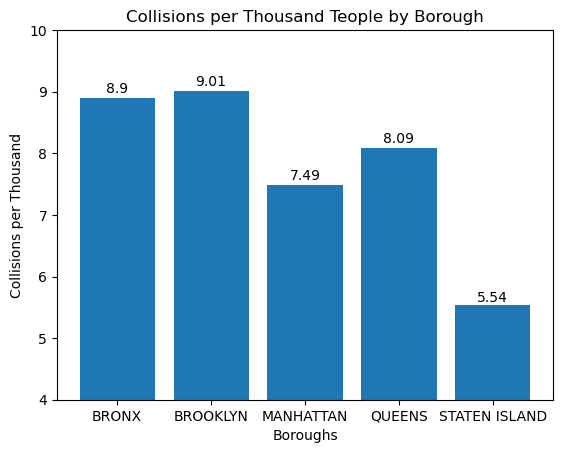
Zip Code#
zc_data = crashes.groupby("ZIP CODE").count()["CRASH DATE"]
zc_df = pd.DataFrame(zc_data).reset_index()
zc_df.rename(columns={"CRASH DATE": "COUNT"}, inplace=True)
zc_df["ZIP CODE"] = zc_df["ZIP CODE"].astype(int)
zc_df.sort_values(by="COUNT", ascending=False)
| ZIP CODE | COUNT | |
|---|---|---|
| 123 | 11207 | 1763 |
| 128 | 11212 | 1128 |
| 151 | 11236 | 1111 |
| 124 | 11208 | 1099 |
| 119 | 11203 | 996 |
| ... | ... | ... |
| 55 | 10153 | 1 |
| 56 | 10154 | 1 |
| 58 | 10158 | 1 |
| 59 | 10165 | 1 |
| 57 | 10155 | 1 |
210 rows × 2 columns

Collisions by Demography#
# credit: https://matplotlib.org/stable/gallery/lines_bars_and_markers/barchart.html
types = ("Pedestrians", "Motorists", "Cyclists")
counts = {"Injured": (crashes["NUMBER OF PEDESTRIANS INJURED"].sum(), crashes["NUMBER OF MOTORIST INJURED"].sum(), crashes["NUMBER OF CYCLIST INJURED"].sum()),
"Killed": (crashes["NUMBER OF PEDESTRIANS KILLED"].sum(), crashes["NUMBER OF MOTORIST KILLED"].sum(), crashes["NUMBER OF CYCLIST KILLED"].sum()),
}
x = np.arange(len(types)) # the label locations
width = 0.25 # the width of the bars
multiplier = 0
fig, ax = plt.subplots(layout='constrained')
for i, j in counts.items():
offset = width * multiplier
rects = ax.bar(x + offset, j, width, label=i)
ax.bar_label(rects, padding=3)
multiplier += 1
ax.set_ylabel('Count')
ax.set_title('Type of person')
ax.set_xticks(x + width*0.5, types)
ax.legend()
ax.set_ylim(0, 42000)
plt.savefig("Charts/Collisons by Vehicle")
plt.show()
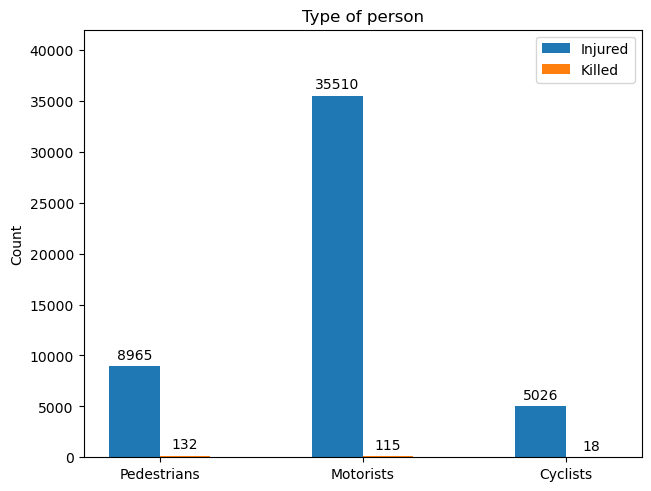
Collisions by Causes#
Top 10 Contributing Factor Vehicle 1#
cfv = utils.get_contributing_factor(crashes).sort_values("CRASH DATE", ascending=False).iloc[1:11]
labels = cfv.index
sizes = cfv["CRASH DATE"]
fig, ax = plt.subplots(figsize=(10, 7))
ax.pie(sizes, labels=labels, autopct='%1.1f%%')
# plt.legend(labels, bbox_to_anchor=(1.5, 0.25, 0.5, 0.5))
plt.savefig("Charts/Collisions by Contributing Factor")
plt.show()

Top 10 Vehicle Type Code 1#
# vtc1 = crashes.groupby("VEHICLE TYPE CODE 1").count()["CRASH DATE"].sort_values(ascending=False).head(10)
vtc = utils.get_vehicle_type(crashes).sort_values("CRASH DATE", ascending=False).iloc[:10]
labels = vtc.index
sizes = vtc["CRASH DATE"]
fig, ax = plt.subplots(figsize=(10, 7))
ax.pie(sizes, labels=labels, autopct='%1.1f%%')
plt.savefig("Charts/Collisions by Vehicle Type Code 1")
plt.show()
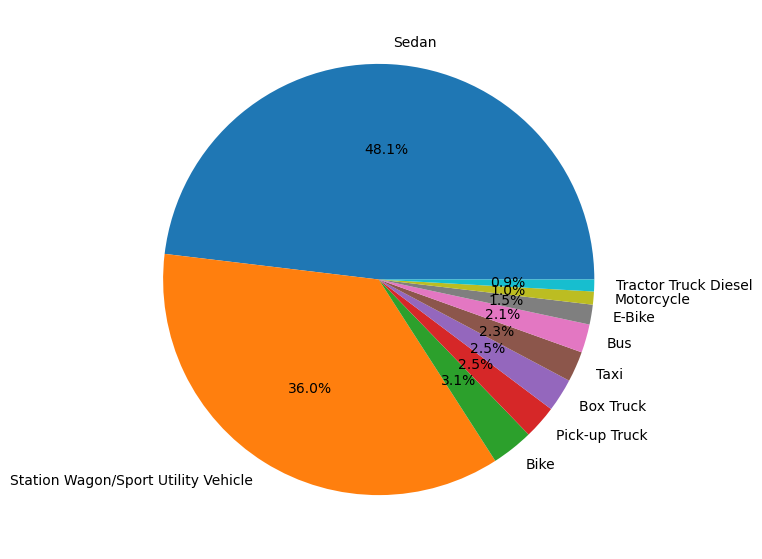
Collisions by Time#
# add month, day and hour to the dataframe
utils.time_processing(crashes)
crashes['CRASH HOUR'][0]
11
crashes
| Unnamed: 0 | CRASH DATE | CRASH TIME | BOROUGH | ZIP CODE | LATITUDE | LONGITUDE | LOCATION | ON STREET NAME | CROSS STREET NAME | ... | COLLISION_ID | VEHICLE TYPE CODE 1 | VEHICLE TYPE CODE 2 | VEHICLE TYPE CODE 3 | VEHICLE TYPE CODE 4 | VEHICLE TYPE CODE 5 | CRASH MONTH | CRASH DAY | CRASH HOUR | DAYOFWEEK | |
|---|---|---|---|---|---|---|---|---|---|---|---|---|---|---|---|---|---|---|---|---|---|
| 0 | 1 | 2022-03-26 | 11:45 | NaN | NaN | NaN | NaN | NaN | QUEENSBORO BRIDGE UPPER | NaN | ... | 4513547 | Sedan | NaN | NaN | NaN | NaN | 03 | 26 | 11 | 5 |
| 1 | 2 | 2022-06-29 | 6:55 | NaN | NaN | NaN | NaN | NaN | THROGS NECK BRIDGE | NaN | ... | 4541903 | Sedan | Pick-up Truck | NaN | NaN | NaN | 06 | 29 | 6 | 2 |
| 2 | 34 | 2022-06-29 | 16:00 | NaN | NaN | NaN | NaN | NaN | WILLIAMSBURG BRIDGE OUTER ROADWA | NaN | ... | 4542336 | Motorscooter | Station Wagon/Sport Utility Vehicle | NaN | NaN | NaN | 06 | 29 | 16 | 2 |
| 3 | 37 | 2022-07-12 | 17:50 | BROOKLYN | 11225.0 | 40.663303 | -73.96049 | (40.663303, -73.96049) | NaN | NaN | ... | 4545699 | Sedan | NaN | NaN | NaN | NaN | 07 | 12 | 17 | 1 |
| 4 | 38 | 2022-03-23 | 10:00 | NaN | NaN | NaN | NaN | NaN | NaN | NaN | ... | 4512922 | Bike | NaN | NaN | NaN | NaN | 03 | 23 | 10 | 2 |
| ... | ... | ... | ... | ... | ... | ... | ... | ... | ... | ... | ... | ... | ... | ... | ... | ... | ... | ... | ... | ... | ... |
| 103782 | 1984602 | 2022-04-24 | 13:00 | BROOKLYN | 11233.0 | 0.000000 | 0.00000 | (0.0, 0.0) | NaN | NaN | ... | 4621496 | Sedan | Station Wagon/Sport Utility Vehicle | Sedan | NaN | NaN | 04 | 24 | 13 | 6 |
| 103783 | 1984724 | 2022-12-06 | 15:52 | BRONX | 10475.0 | 40.877476 | -73.83661 | (40.877476, -73.83661) | BAYCHESTER AVENUE | GIVAN AVENUE | ... | 4621506 | Sedan | Station Wagon/Sport Utility Vehicle | NaN | NaN | NaN | 12 | 06 | 15 | 1 |
| 103784 | 1984763 | 2022-05-26 | 0:00 | BROOKLYN | 11221.0 | 40.690180 | -73.93560 | (40.69018, -73.9356) | NaN | NaN | ... | 4621498 | Station Wagon/Sport Utility Vehicle | Station Wagon/Sport Utility Vehicle | NaN | NaN | NaN | 05 | 26 | 0 | 3 |
| 103785 | 1984817 | 2022-07-18 | 19:00 | BROOKLYN | 11206.0 | 40.694485 | -73.93735 | (40.694485, -73.93735) | LEWIS AVENUE | HART STREET | ... | 4621495 | Bike | NaN | NaN | NaN | NaN | 07 | 18 | 19 | 0 |
| 103786 | 1985218 | 2022-12-11 | 12:00 | QUEENS | 11434.0 | 40.687750 | -73.79039 | (40.68775, -73.79039) | LINDEN BOULEVARD | 157 STREET | ... | 4622208 | Station Wagon/Sport Utility Vehicle | fire truck | NaN | NaN | NaN | 12 | 11 | 12 | 6 |
103787 rows × 34 columns
Month#
month_data = crashes.groupby("CRASH MONTH").count()["CRASH TIME"]
plt.figure(figsize=(8, 6))
# sns.lineplot(month_data.index, month_data.values)
plt.plot(month_data.index, month_data.values)
plt.title("Collisions by Month")
plt.xlabel("Month")
plt.ylabel("Count")
plt.savefig("Charts/Collisions by Month.png")
plt.show()
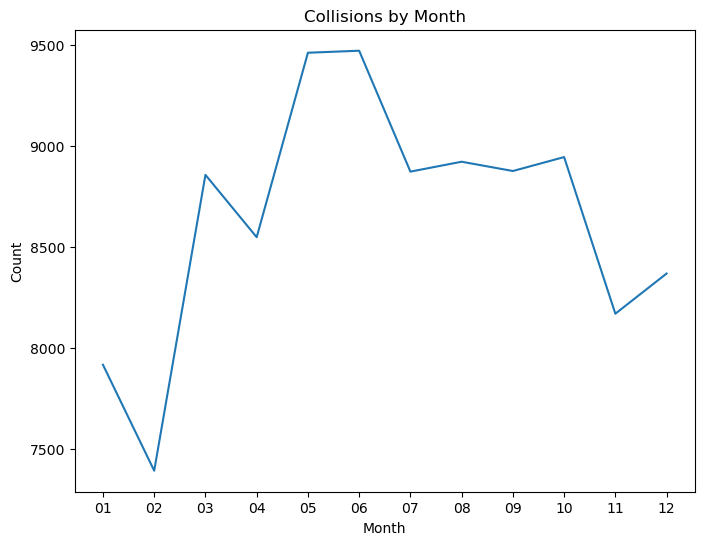
Day#
day_data = crashes.groupby("DAYOFWEEK").count()["CRASH TIME"]
plt.figure(figsize=(8, 6))
plt.bar(day_data.index, day_data.values)
addlabels(day_data.index, day_data.values)
plt.title("Collisions by Day")
plt.xlabel("Day")
plt.ylabel("Count")
plt.ylim((10000, 18000))
plt.savefig("Charts/Collisions by Day")
plt.show()
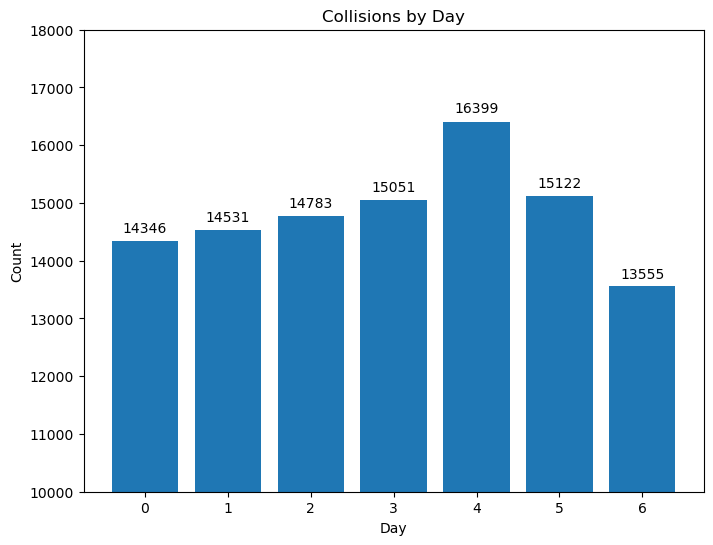
Hour#
weekday_hour_data = crashes[crashes['DAYOFWEEK'] < 5].groupby("CRASH HOUR").count()["CRASH TIME"]/5
weekend_hour_data = crashes[crashes['DAYOFWEEK'] > 4].groupby("CRASH HOUR").count()["CRASH TIME"]/2
plt.figure(figsize=(8, 6))
plt.plot(weekday_hour_data.index, weekday_hour_data.values, label='weekday')
plt.plot(weekend_hour_data.index, weekend_hour_data.values, label='weekend')
plt.title("Collisions Weekday vs. Weekend")
plt.xlabel("Hour")
plt.ylabel("Count")
plt.xticks(np.linspace(0, 23, 24))
plt.legend()
plt.savefig("Charts/Collisions Weekday vs. Weekend.png")
plt.show()
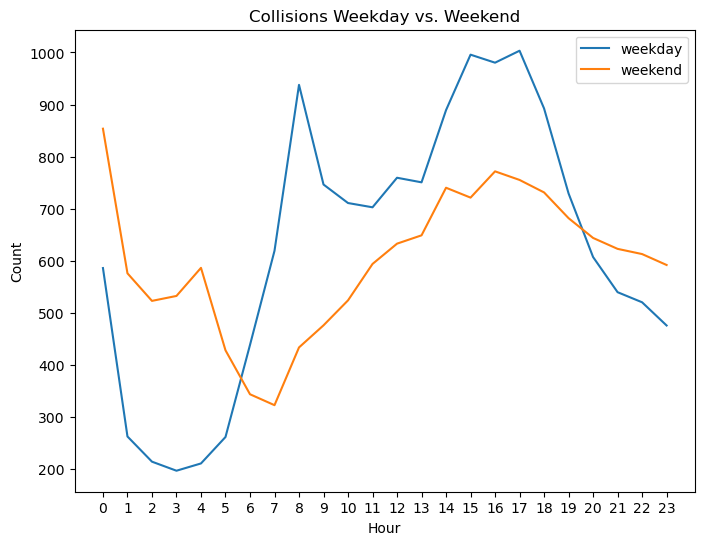
Bivariate analysis:#
Investigate relationships between pairs of features, using scatter plots, box plots, or violin plots. For example, you can explore the relationship between contributing factors and the number of persons injured, or between crash time and crash severity.
crashes_18_22 = dict.fromkeys(range(2014, 2023))
for year in crashes_18_22.keys():
crashes_18_22[year] = utils.read_csv_of_year(year)
utils.time_processing(crashes_18_22[year])
α = 1
crashes_18_22[year]["TOTAL CASUALTIES"] = crashes_18_22[year]["NUMBER OF PERSONS INJURED"] + α * crashes_18_22[year]["NUMBER OF PERSONS KILLED"]
casualties_18_22 = dict.fromkeys(range(2014, 2023))
for year in casualties_18_22.keys():
casualties_18_22[year] = crashes_18_22[year].groupby("CRASH HOUR")["TOTAL CASUALTIES"].mean()
/home/jovyan/project-group19/tool/utils.py:86: DtypeWarning:
Columns (4) have mixed types. Specify dtype option on import or set low_memory=False.
/home/jovyan/project-group19/tool/utils.py:86: DtypeWarning:
Columns (4) have mixed types. Specify dtype option on import or set low_memory=False.
plt.figure(figsize=(8, 6))
for year in casualties_18_22.keys():
plt.plot(casualties_18_22[year].index, casualties_18_22[year].values, label=year)
plt.text(23.5, casualties_18_22[year].values[23], year)
plt.title("Casualties by Hour")
plt.xlabel("Hour")
plt.ylabel("Count")
plt.xticks(np.linspace(0, 23, 24))
plt.xlim((-1, 25))
plt.savefig("Charts/Collisions 2015-2022.png")
plt.show()
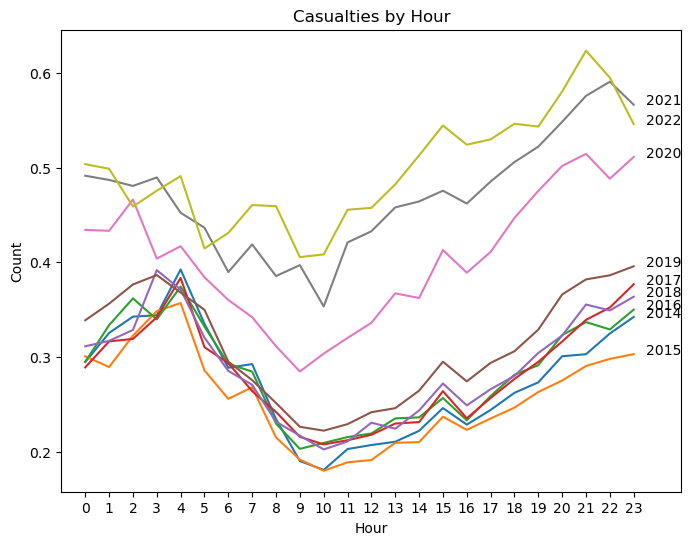
numkilled_18_22 = dict.fromkeys(range(2014, 2023))
for year in crashes_18_22.keys():
numkilled_18_22[year] = crashes_18_22[year]["NUMBER OF PERSONS KILLED"].sum()
plt.figure(figsize=(8, 6))
for year in casualties_18_22.keys():
plt.bar(year, numkilled_18_22[year], label=year)
plt.text(year, numkilled_18_22[year]+2, numkilled_18_22[year], ha="center")
plt.title("Casualties by Year")
plt.xlabel("Year")
plt.ylabel("Number of Casualties")
plt.ylim((200, 300))
plt.savefig("Charts/Plot.png")
plt.show()
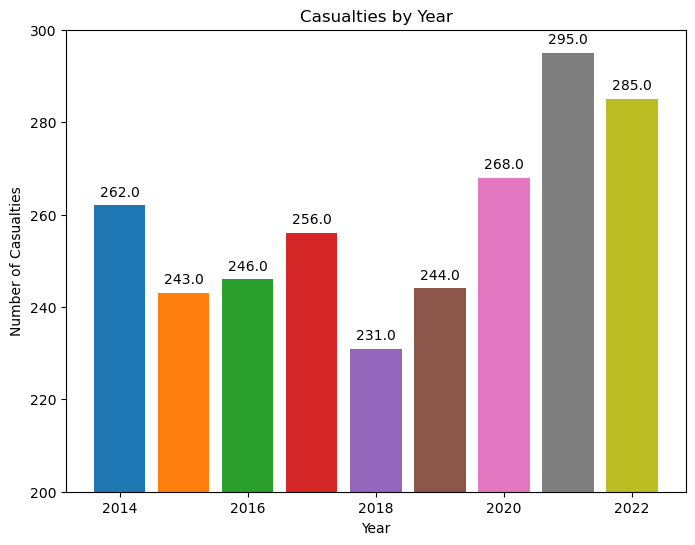
Predicting car crash severity#
Let’s develop a classification machine learning model using a random forest. Define car accident severity as three levels according to the casualties:
minor injury level: 2 or less people injured, no death reported. Label: 0
major injury level: 3 or more people injured, no death reported. Label: 1
fatal injury level: at least one person killed. Label: 2
injury_conditions = [
(crashes["NUMBER OF PERSONS KILLED"] >= 1),
(crashes["NUMBER OF PERSONS INJURED"] >= 3) & (crashes["NUMBER OF PERSONS KILLED"] == 0),
(crashes["NUMBER OF PERSONS INJURED"] <= 2) & (crashes["NUMBER OF PERSONS KILLED"] == 0),
]
injury_values = [2, 1, 0]
time_conditions = [
(crashes['CRASH HOUR'] <= 11) & (crashes['CRASH HOUR'] >= 6),
(crashes['CRASH HOUR'] <= 17) & (crashes['CRASH HOUR'] >= 12),
(crashes['CRASH HOUR'] <= 5) | (crashes['CRASH HOUR'] >= 18),
]
time_values = ['morning', 'afternoon', 'after sunset']
vehicle1_conditions = [
(crashes['VEHICLE TYPE CODE 1'].str.contains('Sedan', na=False)),
(crashes['VEHICLE TYPE CODE 1'].str.contains('Sport', na=False)),
(crashes['VEHICLE TYPE CODE 1'].str.contains('Truck', na=False)),
(crashes['VEHICLE TYPE CODE 1'].str.contains('Taxi', na=False)),
(crashes['VEHICLE TYPE CODE 1'].str.contains('Bus', na=False)),
(crashes['VEHICLE TYPE CODE 1'].str.contains('Motor', na=False)),
(crashes['VEHICLE TYPE CODE 1'].str.contains('Bike', na=False)),
(crashes['VEHICLE TYPE CODE 1'].str.contains('Pick-up', na=False)),
(crashes['VEHICLE TYPE CODE 1'].notna() | crashes['VEHICLE TYPE CODE 1'].isna())
]
vehicle1_values = ['sedan', 'suv', 'truck', 'taxi', 'bus', 'motor', 'bike', 'pick-up', 'other']
vehicle2_conditions = [
(crashes['VEHICLE TYPE CODE 2'].str.contains('Sedan', na=False)),
(crashes['VEHICLE TYPE CODE 2'].str.contains('Sport', na=False)),
(crashes['VEHICLE TYPE CODE 2'].str.contains('Truck', na=False)),
(crashes['VEHICLE TYPE CODE 2'].str.contains('Taxi', na=False)),
(crashes['VEHICLE TYPE CODE 2'].str.contains('Bus', na=False)),
(crashes['VEHICLE TYPE CODE 2'].str.contains('Motor', na=False)),
(crashes['VEHICLE TYPE CODE 2'].str.contains('Bike', na=False)),
(crashes['VEHICLE TYPE CODE 2'].str.contains('Pick-up', na=False)),
(crashes['VEHICLE TYPE CODE 2'].notna() | crashes['VEHICLE TYPE CODE 2'].isna())
]
vehicle2_values = ['sedan', 'suv', 'truck', 'taxi', 'bus', 'motor', 'bike', 'pick-up', 'other']
# add labels of injury severity
crashes['INJURY LEVEL'] = np.select(injury_conditions, injury_values)
crashes['TIME OF DAY'] = np.select(time_conditions, time_values)
crashes['VEHICLE TYPE 1'] = np.select(vehicle1_conditions, vehicle1_values)
crashes['VEHICLE TYPE 2'] = np.select(vehicle2_conditions, vehicle2_values)
col_list = ['CONTRIBUTING FACTOR VEHICLE 1',
'CONTRIBUTING FACTOR VEHICLE 2', 'CONTRIBUTING FACTOR VEHICLE 3',
'CONTRIBUTING FACTOR VEHICLE 4', 'CONTRIBUTING FACTOR VEHICLE 5']
crashes['NUM OF CARS'] = 5 - crashes[col_list].isna().sum(axis=1)
data = crashes[crashes['VEHICLE TYPE 1'] != 'other']
df0 = data[data['INJURY LEVEL'] == 0].sample(20000)
df1 = data[data['INJURY LEVEL'] == 1]
df2 = data[data['INJURY LEVEL'] == 2]
frames = [df0, df1, df2]
data = pd.concat(frames)
data = data.dropna(subset=['BOROUGH'])
features = ['TIME OF DAY', 'NUM OF CARS', 'DAYOFWEEK', 'VEHICLE TYPE 1', 'VEHICLE TYPE 2', 'BOROUGH'] #
X = data[features]
y = data['INJURY LEVEL']
# one hot encoding
encoded_X = pd.get_dummies(X, drop_first=True)
encoded_X
| NUM OF CARS | DAYOFWEEK | TIME OF DAY_afternoon | TIME OF DAY_morning | VEHICLE TYPE 1_bus | VEHICLE TYPE 1_motor | VEHICLE TYPE 1_sedan | VEHICLE TYPE 1_suv | VEHICLE TYPE 1_taxi | VEHICLE TYPE 1_truck | ... | VEHICLE TYPE 2_motor | VEHICLE TYPE 2_other | VEHICLE TYPE 2_sedan | VEHICLE TYPE 2_suv | VEHICLE TYPE 2_taxi | VEHICLE TYPE 2_truck | BOROUGH_BROOKLYN | BOROUGH_MANHATTAN | BOROUGH_QUEENS | BOROUGH_STATEN ISLAND | |
|---|---|---|---|---|---|---|---|---|---|---|---|---|---|---|---|---|---|---|---|---|---|
| 12672 | 1 | 0 | 0 | 1 | 0 | 0 | 0 | 0 | 0 | 0 | ... | 0 | 1 | 0 | 0 | 0 | 0 | 0 | 1 | 0 | 0 |
| 89057 | 2 | 0 | 1 | 0 | 0 | 0 | 1 | 0 | 0 | 0 | ... | 0 | 0 | 1 | 0 | 0 | 0 | 1 | 0 | 0 | 0 |
| 92419 | 2 | 1 | 1 | 0 | 0 | 0 | 0 | 1 | 0 | 0 | ... | 0 | 0 | 0 | 0 | 0 | 1 | 0 | 0 | 1 | 0 |
| 85587 | 2 | 5 | 1 | 0 | 0 | 0 | 0 | 1 | 0 | 0 | ... | 0 | 0 | 0 | 0 | 0 | 0 | 1 | 0 | 0 | 0 |
| 86954 | 2 | 3 | 0 | 0 | 0 | 0 | 1 | 0 | 0 | 0 | ... | 0 | 0 | 1 | 0 | 0 | 0 | 0 | 0 | 1 | 0 |
| ... | ... | ... | ... | ... | ... | ... | ... | ... | ... | ... | ... | ... | ... | ... | ... | ... | ... | ... | ... | ... | ... |
| 103667 | 1 | 4 | 1 | 0 | 0 | 0 | 0 | 1 | 0 | 0 | ... | 0 | 1 | 0 | 0 | 0 | 0 | 0 | 1 | 0 | 0 |
| 103734 | 1 | 4 | 0 | 0 | 0 | 0 | 0 | 1 | 0 | 0 | ... | 0 | 1 | 0 | 0 | 0 | 0 | 0 | 0 | 0 | 0 |
| 103735 | 2 | 2 | 1 | 0 | 0 | 0 | 0 | 1 | 0 | 0 | ... | 1 | 0 | 0 | 0 | 0 | 0 | 1 | 0 | 0 | 0 |
| 103736 | 2 | 2 | 1 | 0 | 0 | 0 | 0 | 1 | 0 | 0 | ... | 0 | 0 | 0 | 0 | 0 | 0 | 1 | 0 | 0 | 0 |
| 103738 | 1 | 6 | 0 | 0 | 0 | 0 | 0 | 1 | 0 | 0 | ... | 0 | 1 | 0 | 0 | 0 | 0 | 0 | 1 | 0 | 0 |
14826 rows × 21 columns
run on Random Forest model#
# import the necessary liabrary
from sklearn.model_selection import train_test_split
from sklearn.ensemble import RandomForestClassifier
from sklearn.metrics import confusion_matrix, classification_report, f1_score
# train and test split and building baseline model to predict target features
X_train, X_test, y_train, y_test = train_test_split(encoded_X, y, test_size=0.2, random_state=42)
# modelling using random forest baseline
rf = RandomForestClassifier(n_estimators=500, max_depth=30, random_state=42)
rf.fit(X_train, y_train)
# predicting on test data
predics = rf.predict(X_test)
# train score
print('Training accuracy: %.2f %%' % (rf.score(X_train, y_train)*100))
# test score
print('Training accuracy: %.2f %%' % (rf.score(X_test, y_test)*100))
Training accuracy: 91.77 %
Training accuracy: 88.37 %
run on logistic regression model#
from sklearn.model_selection import train_test_split
from sklearn.preprocessing import StandardScaler
from sklearn.linear_model import LogisticRegression
from sklearn.pipeline import Pipeline
from sklearn.metrics import roc_curve, roc_auc_score, classification_report, accuracy_score, confusion_matrix
scaler = StandardScaler()
lr = LogisticRegression()
model1 = Pipeline([('standardize', scaler), ('log_reg', lr)])
model1.fit(X_train, y_train)
Pipeline(steps=[('standardize', StandardScaler()),
('log_reg', LogisticRegression())])In a Jupyter environment, please rerun this cell to show the HTML representation or trust the notebook. On GitHub, the HTML representation is unable to render, please try loading this page with nbviewer.org.
Pipeline(steps=[('standardize', StandardScaler()),
('log_reg', LogisticRegression())])StandardScaler()
LogisticRegression()
Pipeline(steps=[('standardize', StandardScaler()),
('log_reg', LogisticRegression())])
Pipeline(steps=[('standardize', StandardScaler()),
('log_reg', LogisticRegression())])In a Jupyter environment, please rerun this cell to show the HTML representation or trust the notebook. On GitHub, the HTML representation is unable to render, please try loading this page with nbviewer.org.
Pipeline(steps=[('standardize', StandardScaler()),
('log_reg', LogisticRegression())])StandardScaler()
LogisticRegression()
y_train_hat = model1.predict(X_train)
y_train_hat_probs = model1.predict_proba(X_train)[:, 1]
train_accuracy = accuracy_score(y_train, y_train_hat)*100
# print('Confusion matrix:\n', confusion_matrix(y_train, y_train_hat))
print('Training accuracy: %.2f %%' % train_accuracy)
Training accuracy: 89.59 %
y_test_hat = model1.predict(X_test)
y_test_hat_probs = model1.predict_proba(X_test)[:, 1]
test_accuracy = accuracy_score(y_test, y_test_hat)*100
print('Testing accuracy: %.2f %%' % test_accuracy)
Testing accuracy: 90.22 %
A test score of around 90% means that your random forest model is correctly predicting the injury severity of car accidents about 90% of the time. While this is much better than random guessing, there is still room for improvement. Here are a few suggestions on how to improve it:
Feature engineering: The features selected might not be sufficient. Could consider adding more features, such as weather conditions, road conditions, speed limits, or driver demographics.
Hyperparameter tuning: Random forest models have several hyperparameters that can significantly impact their performance. Use techniques like grid search or random search to find the optimal hyperparameters for your model (e.g., the number of trees, maximum depth, minimum samples per leaf).
Feature selection: Some features might not contribute to improving the model’s performance, or they could be causing multicollinearity. Apply feature selection techniques like recursive feature elimination, LASSO regression, or chi-squared test to find the most relevant features for your model.
Ensemble methods: Combine multiple models using techniques like bagging, boosting, or stacking to improve the overall performance.

